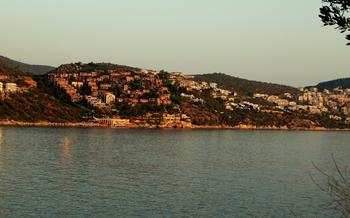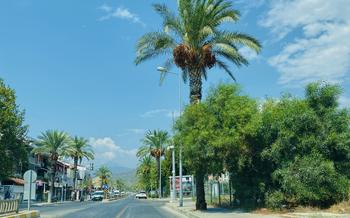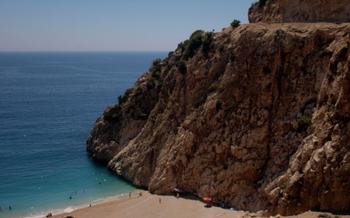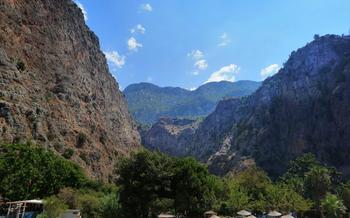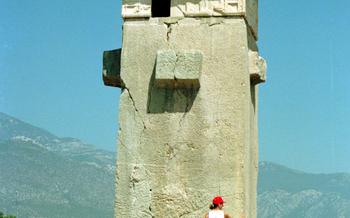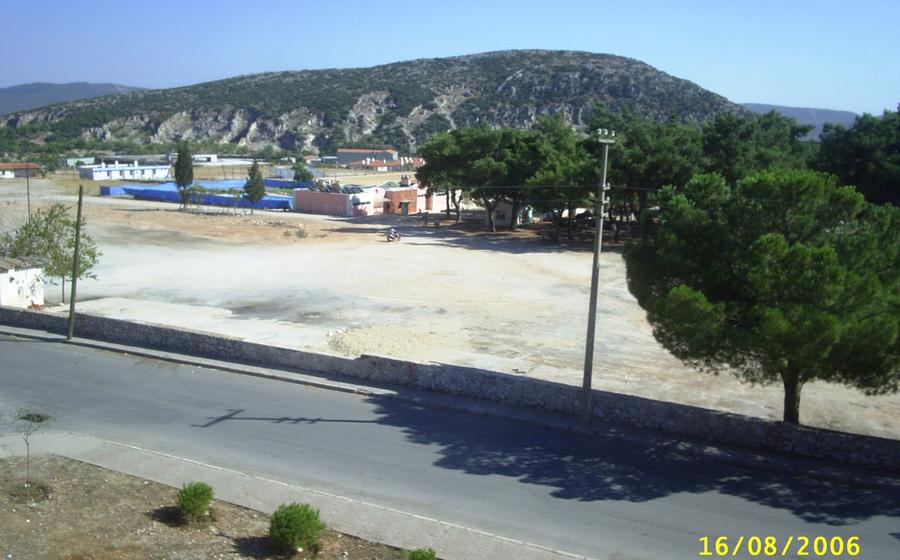
Letoon Ancient City
- Historical Significance
- Architectural Marvels
- Excavation and Discoveries
- Religious Center
- Cultural Crossroads
- Natural Beauty
- UNESCO World Heritage Site
- Visitor Experience
- Local Cuisine and Hospitality
- Accommodations and Amenities
- Nearby Attractions
- Sustainable Tourism
- Photography Tips
Historical Significance
In the heart of ancient Lycia, nestled along the fertile banks of the Xanthus River, lies the remarkable city of Letoon. This sacred site, steeped in history and mythology, served as a prominent religious and cultural center for centuries. Letoon's significance stemmed from its deep connection to the goddess Leto and her divine children, Apollo and Artemis. As the birthplace of these revered deities, the city became a sanctuary, attracting pilgrims and worshippers from across the Lycian realm and beyond.
Letoon's strategic location further enhanced its importance. Situated at the crossroads of major trade routes, it served as a hub for cultural exchange and commerce. Its proximity to other prominent Lycian cities, such as Xanthos and Patara, fostered a sense of unity and cooperation among the Lycian League, a confederation of city-states that flourished in the region.
Architectural Marvels
Letoon's architectural achievements are a testament to the skill and artistry of the ancient Lycians. The most impressive structure is undoubtedly the Temple of Leto, with its iconic columns and intricate carvings. Built in the 4th century BC, the temple is dedicated to the goddess Leto and is considered one of the finest examples of Greek architecture in Turkey. Its well-preserved remains allow visitors to appreciate the grandeur and beauty of this ancient sanctuary.
Other notable architectural wonders in Letoon include the Bouleuterion, a council chamber where civic matters were discussed; the Theater, which hosted performances and public gatherings; and the agora, the bustling marketplace where people traded goods and socialized. These structures, though not as grand as the Temple of Leto, provide valuable insights into the daily life and civic organization of the ancient Lycians.
Exploring Letoon's architectural marvels is a journey through time, allowing visitors to admire the ingenuity and creativity of a civilization that left an indelible mark on history.
Excavation and Discoveries
The buried treasures of Letoon began to be unearthed in the late 19th century when French archaeologists embarked on a series of excavations that brought to light the city's remarkable ruins. These pioneering efforts laid the groundwork for subsequent excavations conducted by Turkish archaeologists, who have meticulously uncovered the city's secrets and shed light on its rich history.
Among the most significant discoveries made at Letoon are the well-preserved remains of the Temple of Leto, which showcase the city's architectural prowess. The temple's imposing columns, intricate carvings, and stunning pediments have captivated visitors and scholars alike. The excavations have also revealed a wealth of artifacts, including inscriptions, sculptures, and pottery, which offer valuable insights into the daily lives, religious beliefs, and cultural practices of the ancient Lycians.
One of the most remarkable discoveries at Letoon is the Bilingual Inscription, which dates back to the 4th century BC. This inscription, written in both Greek and Lycian, provides crucial information about the city's history, administration, and religious practices. It also sheds light on the complex relationship between the Lycians and the neighboring Greek city-states, highlighting the cultural exchange and influences that shaped the region during antiquity.
The ongoing excavations at Letoon continue to yield exciting discoveries that contribute to our understanding of this ancient city. With each new find, Letoon reveals more of its fascinating story, captivating visitors and inspiring researchers to delve deeper into the mysteries of this remarkable archaeological site.
Religious Center
Letoon was not just a city of architectural wonders; it was also a pivotal religious center in ancient Lycia. The city's sacred aura emanated from its dedication to the worship of Leto and her children, Apollo and Artemis. Within the city's sacred precincts, solemn rituals and ceremonies unfolded, honoring these revered deities.
The Temple of Leto, the city's most prominent edifice, served as the focal point of religious devotion. Here, priests and priestesses performed sacred rites, offering prayers, libations, and sacrifices to appease the gods and seek their blessings. The air was thick with the scent of incense, the murmur of prayers, and the melody of hymns that resonated through the temple's hallowed halls.
Beyond the Temple of Leto, other sanctuaries and altars dotted the city's landscape, each dedicated to a specific deity. The Lycians held their gods in high esteem, and religious festivals were celebrated with great fervor and pageantry. These festivals brought the community together, fostering unity and reinforcing the bonds of faith that united the Lycians.
Letoon's religious significance extended far beyond the city's walls. It was a place of pilgrimage for people from all corners of Lycia and beyond. Devotees flocked to the city to pay homage to Leto and her children, seeking divine favor and spiritual renewal. The city's sacred aura and reputation as a sanctuary attracted pilgrims from distant lands, solidifying Letoon's status as a prominent religious center in the ancient world.
Cultural Crossroads
Letoon stood as a vibrant cultural crossroads in ancient Lycia, where Greek, Lycian, and other influences intertwined to create a unique and diverse cityscape. The city's architecture showcased a harmonious blend of styles, with Greek temples adorned with intricate Lycian motifs. The theater, with its well-preserved stage and seating, hosted performances that drew inspiration from both Greek and Lycian traditions. The agora, the bustling marketplace, was a melting pot of cultures, where traders from across the region exchanged goods and ideas. This cultural diversity left an indelible mark on Letoon, shaping its identity and contributing to the rich tapestry of the Lycian civilization.
Natural Beauty
Letoon is not just a treasure trove of ancient history and culture; it is also a place of extraordinary natural beauty. The city is surrounded by lush greenery, with towering trees and vibrant flowers adding a splash of color to the landscape. The Xanthus River, with its crystal-clear waters, meanders through the city, creating a serene and picturesque backdrop.
As you explore Letoon, you'll be captivated by the breathtaking views that unfold at every turn. The ancient ruins, set against the backdrop of the lush vegetation and the sparkling river, create a harmonious and awe-inspiring experience. The natural beauty of Letoon complements its historical and cultural significance, making it a truly unforgettable destination.
One of the best ways to experience Letoon's natural beauty is to take a leisurely walk along the Xanthus River. As you stroll along the riverbank, you'll be surrounded by the sounds of birdsong and the gentle lapping of the water against the shore. The river's crystal-clear waters offer glimpses of the ancient city's submerged treasures, including the remains of bridges and other structures.
Another great way to appreciate Letoon's natural beauty is to climb to the top of the acropolis. From this vantage point, you'll be rewarded with stunning panoramic views of the city and its surroundings. The lush green valleys, the sparkling river, and the distant mountains create a breathtaking vista that will leave you in awe.
Letoon's natural beauty is an integral part of its allure. It's a place where history, culture, and nature come together to create a truly unique and unforgettable experience.
UNESCO World Heritage Site
Letoon's exceptional cultural and historical significance has been recognized by its inscription on the UNESCO World Heritage List in 198This prestigious designation highlights the site's outstanding universal value and its importance in preserving global cultural heritage. UNESCO's criteria for inscription include the site's representation of a unique cultural tradition, its exceptional testimony to a vanished civilization, and its outstanding examples of architecture and monumental arts. Letoon fulfills all these criteria, showcasing a remarkable blend of Greek and Lycian architectural styles and serving as a testament to the rich cultural heritage of the ancient Lycian civilization. UNESCO's recognition ensures that Letoon will be protected and preserved for future generations to appreciate and learn from, contributing to the preservation of our shared cultural heritage.
Visitor Experience
Planning a trip to Letoon is a rewarding experience that offers a glimpse into ancient history and natural splendor. The best time to visit is during the shoulder seasons (spring and autumn) when the weather is pleasant, and the crowds are smaller. Letoon is open to visitors daily, and the entrance fee is minimal. The city is easily accessible by car or public transportation, and there are guided tours available for those who prefer a more in-depth exploration.
To fully appreciate Letoon's charm, take your time exploring the ancient ruins and immersing yourself in the tranquil atmosphere. Stroll along the paved paths, admire the well-preserved structures, and let your imagination transport you back to ancient times. Don't forget to bring your camera to capture the essence of this remarkable place. Guided tours are available for those who want to learn more about the city's history and significance.
Letoon is a photographer's paradise, with countless opportunities to capture stunning images. The best time for photography is either early morning or late afternoon when the light is soft and golden. Experiment with different angles and vantage points to create unique and memorable shots. Whether you're a seasoned photographer or just starting, Letoon will provide ample inspiration for your creative endeavors.
Local Cuisine and Hospitality
The flavors of Muğla are as diverse and captivating as its historical and cultural heritage. Savor the delectable delights of traditional Turkish cuisine, where fresh, local ingredients are transformed into mouthwatering culinary creations. Indulge in the aromatic kebabs, tantalize your taste buds with savory mezes, and relish the sweetness of traditional Turkish desserts.
The people of Muğla are renowned for their warm hospitality and welcoming nature. Their pride in their cultural heritage shines through in their interactions with visitors, creating a genuine and enriching cultural exchange. Engage with the locals, learn about their traditions and customs, and immerse yourself in the vibrant tapestry of Turkish culture.
For an authentic culinary experience, venture into the heart of Muğla and discover hidden gems where locals gather to savor traditional dishes. From cozy family-run restaurants to lively cafes, there are countless opportunities to indulge in the flavors of Muğla. Embrace the spirit of Turkish hospitality and allow the warmth of the local people to enhance your journey through this extraordinary region.
Accommodations and Amenities
Muğla offers a wide range of accommodation options to suit every budget and preference. From cozy guesthouses and charming bed and breakfasts to upscale hotels and luxurious resorts, there's something for every traveler. For those seeking an immersive cultural experience, traditional Turkish guesthouses provide a unique opportunity to connect with local families and experience authentic Turkish hospitality. These guesthouses often feature traditional architecture, local cuisine, and warm, welcoming hosts who are eager to share their culture and traditions.
In terms of amenities, Muğla is well-equipped to cater to the needs of visitors. The city boasts a variety of restaurants, cafes, and shops, offering everything from traditional Turkish cuisine to international fare. There are also several supermarkets and grocery stores where visitors can stock up on supplies. Transportation options are convenient and reliable, with buses and taxis readily available. For those who prefer to explore the city at their own pace, car rentals are also available.
When it comes to choosing the best area to stay in Muğla, there are a few factors to consider. For those primarily interested in visiting Letoon, it's recommended to stay in the city center, which is just a short drive away. The city center is also home to many historical sites, museums, and cultural attractions. For those seeking a more relaxed and tranquil atmosphere, the coastal towns of Datça and Marmaris, both within easy reach of Letoon, offer a variety of beachfront hotels and resorts.
Nearby Attractions
Beyond the enchanting ruins of Letoon, the Muğla region offers a wealth of other attractions that beckon travelers to explore its rich historical and cultural tapestry. A short drive away lies the ancient city of Xanthos, the former capital of Lycia, renowned for its impressive acropolis, monumental tombs, and well-preserved theater. Xanthos, too, holds the distinction of being a UNESCO World Heritage Site, a testament to its exceptional cultural significance.
Nature enthusiasts will find solace in the stunning Saklıkent Gorge, a breathtaking natural wonder located just a stone's throw from Letoon. This picturesque gorge, carved by the relentless force of the Karadere River, offers a mesmerizing spectacle of towering cliffs, cascading waterfalls, and lush vegetation. Visitors can embark on a thrilling rafting adventure through the gorge's narrow channels or take a leisurely walk along its scenic trails, immersing themselves in the tranquility of nature.
For those seeking a coastal retreat, the pristine beaches of Patara beckon with their golden sands and crystal-clear waters. This ancient city, once a major port and trading hub, now offers visitors a chance to relax and soak up the sun on its idyllic shores. History buffs can also explore the well-preserved ruins of Patara, including its impressive theater, agora, and baths, which provide a glimpse into the city's glorious past.
These are just a few of the many treasures that await travelers in the Muğla region. With its diverse range of attractions, from ancient ruins to natural wonders, Muğla offers an unforgettable journey through history, culture, and breathtaking landscapes.
Sustainable Tourism
As you explore the ancient ruins of Letoon, it's essential to embrace responsible and sustainable tourism practices. Here are some tips to minimize your environmental impact and support the local community:
-
Tread Lightly: Respect the fragile nature of the archaeological site by staying on designated paths and avoiding touching or climbing on ancient structures.
-
Embrace Slow Travel: Take your time exploring Letoon's ruins, allowing yourself to fully immerse in its history and beauty. Slow travel not only enhances your experience but also reduces your carbon footprint.
-
Support Local Businesses: Choose to dine at local restaurants and shop for souvenirs from local artisans. This supports the local economy and preserves traditional crafts.
-
Reduce Plastic Waste: Bring your own reusable water bottle and avoid single-use plastics like plastic bags and straws. Proper waste disposal is crucial to protect the environment and marine life.
-
Engage with the Community: Interact with local people, learn about their culture, and share your experiences respectfully. This fosters cultural exchange and promotes mutual understanding.
By practicing sustainable tourism, you can help preserve Letoon's historical treasures for future generations while contributing to the well-being of the local community.
Photography Tips
Capture the Magic of Letoon Through Your Lens
Golden Hour Magic: Embrace the ethereal light of dawn or dusk to capture the ancient ruins bathed in a warm, golden glow. This soft, diffused light enhances the textures and colors of the ruins, creating a captivating atmosphere.
Play with Shadows: Utilize the interplay of light and shadow to add depth and drama to your photographs. Experiment with different angles and perspectives to create striking silhouettes and emphasize the architectural details of the ruins.
Wide-Angle Wonders: Capture the grandeur of Letoon's sprawling ruins with a wide-angle lens. This technique allows you to encompass the vastness of the site and convey the sense of awe and wonder it inspires.
Close-Up Details: Don't overlook the intricate details that bring Letoon to life. Get close to the intricate carvings, worn inscriptions, and weathered surfaces to reveal the stories etched in stone.
Human Element: Incorporate the human element into your photographs by including visitors exploring the ruins. This adds a sense of scale and invites viewers to imagine themselves walking among the ancient structures.
Drone's Eye View: If you have the opportunity, take advantage of drone photography to capture breathtaking aerial shots of Letoon. This perspective offers a unique vantage point and allows you to showcase the site's relationship to the surrounding landscape.


